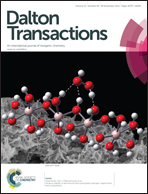Analysis of trivalent cation complexation to functionalized mesoporous silica using solid-state NMR spectroscopy†
Abstract
Functionalized mesoporous silica has applications in separations science, catalysis, and sensors. In this work, we studied the fundamental interactions of trivalent cations with functionalized mesoporous silica. We contacted trivalent cations of varying ionic radii with N-[5-(trimethoxysilyl)-2-aza-1-oxopentyl]caprolactam functionalized mesoporous silica with the aim of probing the binding mechanism of the metal to the surface of the solid. We studied the functionalized silica using solid-state nuclear magnetic resonance (NMR) spectroscopy before and after contact with the metals of interest. We collected NMR spectra of the various metals, as well as of 29Si and 13C to probe the silica substrate and the ligand properties, respectively. The NMR spectra indicate that the metals bind to the functionalized silica via two mechanisms. Aluminum sorbed to both the silica and the ligand, but with different coordination for each. Scandium also sorbed to both the silica and the ligand, and unlike the aluminum, had the same coordination number. Additionally, the functionalized silica was susceptible to acid hydrolysis and two primary mechanisms of degradation were observed: detachment from the silica surface and opening of the seven-membered ring in the ligand. Opening of the seven-membered ring may be beneficial in that it decreases steric hindrance of the molecule for binding.


 Please wait while we load your content...
Please wait while we load your content...